Adolf von Harnack Collection (22 vols.)
Digital Logos Edition
Overview
Adolf von Harnack was one of the most influential biblical scholars of the turn of the twentieth century. His writings, noted for their in-depth historical research, assist his readers in the study of biblical interpretation, Christian living, and dogmatics through the lens of history. Including seven noted volumes on the history of dogma, as well as the first ever volumes covering the topic of missions in the first three centuries, the Adolf von Harnack Collection (22 vols.) is a fantastic resource for pastors, teachers, laity, students, and anybody hoping for a firmer grasp on the history of Christianity and dogmatics.
A professor in Germany as well as a historian and theologian, Harnack lectured at the University level for over fifty years, influencing thousands of students throughout his lifetime. What is perhaps his most famous volume, entitled “What is Christianity?,” is included in this set—comprised of 16 lectures originally given to students in Berlin, it dissects one of the most basic yet important theological questions that can be asked. The Adolf von Harnack Collection (22 vols.) contains several other noted lectures as well, in addition to the multiple volumes addressing dogmatics, historical accounts of the Church, and biblical studies.
The perfect addition to your Logos collection, these volumes in digital format can be instantaneously searched, providing hundreds of results at the click of a mouse. What’s more, you can access scripture references contained in Harnack’s works with a quick mouse-over, and in the Logos edition, you can easily pull biblical studies and dogmatics resources up alongside your favorite Bible for ease of study.
This title is included in the following collections
You can save when you purchase this product as part of a collection.
Verbum 7 Portfolio Legacy Libr...
$4,749.99$4,749.99

- Two volumes detailing the history of Christian missions in the first three centuries after Christ’s birth
- Extensive historical background on the church and biblical interpretation
- Nearly 7,000 pages of writing from one of Europe’s most influential Protestant historians from the turn of the twentieth century
Adolf von Harnack was the foremost German proponent of a liberal theological program, and one of the most provocative and prolific theologians of his time.
—Online Reviewer
- Title: Adolf van Harnack Collection
- Author: Adolph von Harnack
- Volumes: 22
- Pages: 6,914
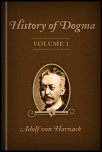
Arguably, there is nobody better than historian Adolph von Harnack to discuss the history of dogma. He meticulously works his way through the definition, limits, divisions, and formation of dogma, covering its history from the early Church to the time of Nitzsch, Loofs, and Renan in this first volume. Dissecting the place of the Gospel of Christ in the history of the Church, this volume ends with an appendix entitled “The Christianity of the Jewish Christians,” which provides a backdrop to the history of Christian Judaism.
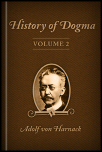
The 358 pages contained in this volume are brimming with studies of the growth, change, and evolution of the early Church’s doctrine. Beginning with the second century and Gnosticism, the book outlines different veins of thought that arose, ending with Origen, an Egyptian theologian and biblical scholar who lived from 185–254 AD. Harnack’s observations on Christianity as it relates to early philosophy and science are included.
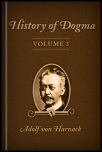
History of Dogma, vol. 3 is divided into two parts. Part one, entitled “Second Book Continued,” discusses the doctrine of Logos, defined by Harnack as “the doctrine of the pre-existence of Christ as a distinct person.” He then delves into modalistic monarchians, the doctrine of Sabellius, the Alexandrian training school, and many well-known theologians from the fourth century.
Part two of History of Dogma, vol. 3 is labeled “The Development of Ecclesiastical Dogma.” Harnack states “the first main division of the history of dogma closed with the adoption of the Logos doctrine as the central dogma of the Church, and with the accompanying revision in the East of the old formulas of the faith under the influence of philosophical theology.” He examines this ecclesiastical paradigm shift in a comprehensive manner, sketching the history of dogma until the eighth century.
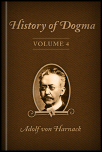
The doctrine of Homousia states that God the Son is similar to, but not the same as, God the Father. Although rejected by the Church in the third century, this doctrine became more widespread at a later date in history, and this volume follows the rise of its popularity, addressing the opposing school of thought as well. The First Council of Nicaea, which occurred in 325 AD, was in part a reaction to this Homoiousian doctrine, and aimed to settle the dispute that Jesus Christ the Son was not also God the Father. History of Dogma, vol. 4 explores these thought processes and historic events through the fifth century.
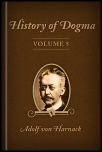
Augustine, a philosopher and theologian during the turn of the fourth century, was a highly influential figure in the dogma of the Church, up until the period of the Carlovingian Renaissance. This volume covers the history of dogma during mediaeval times and contains a general index in at the end. The Lord’s supper, the sacraments, baptism, the Kingdom of God, and catholicity are a few of the many topics addressed.
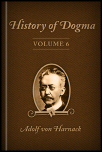
Monastic training of clergy, Scholasticism, and Mysticism are all discussed in History of Dogma, vol. 6. The volume continues until the time of Wycliffe and St. Thomas, also delving into the topics of confirmation, confession, marriage, and priesthood.
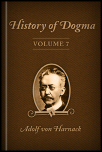
Detailing the history of dogma from the eleventh to the sixteenth century, this volume concludes Harnack’s seven-volume set. Curialism and its opposition are discussed, as is dogma in Roman Catholicism, Antitrinitarinanism, Socinianism, and Protestantism. Luther’s theology ends this resource.
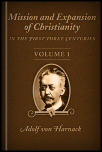
A highly significant set of volumes, Mission and Expansion of Christianity in the First Three Centuries (2 vols.) is the first attempt ever to chronicle the history of missions from the first three centuries, although church history and dogma have previously been charted. Topics covered in volume one include a discussion of the diffusion and limits of Judaism, external conditions assisting with the expansion of Christianity, and an analysis of missions in light of the Gospel. Examples of missionaries from that era are also included, as are their methods of evangelism.
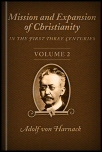
His vast knowledge shining through, Harnack details the spread of Christianity from the time of Christ to the third century. The first chapter of this volume outlines the significant main events that led to its expansion, and following chapters detail the rise of Christianity among aristocrats, in the courts, in the army, and among women. An appendix on church-building is contained, as are maps. This resource provides a great overview to the growth of the Church all over the world for the first three centuries after Christ’s birth.
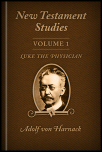
The first of five volumes of New Testament studies, this volume is focused entirely on Luke, whose writings make up the third New Testament gospel as well as the book of Acts. Questions regarding authorship, linguistics, and a comparison of the gospel of Luke to that of John are included in this valuable study.
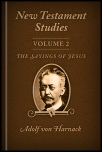
“In St. Matthew are found about 112 words, and in St. Luke (without the Acts) about 261, which occur in these gospels and do not occur elsewhere in the New Testament.” Harnack prefaced this volume with those words, analyzing the instances of each of those words within those two gospels. His linguistic and historical investigation of Matthew and Luke are thought-provoking and provide a fresh way to see the words of Jesus as told in those two New Testament resources.
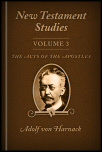
The book of Acts contains an incredible amount of theological importance, as well as great historical value. Undertaking the enormous task of analyzing this book, Harnack does so within the frame of his vast historical knowledge. Sections contained discuss the chronological data, nations and cities included, the treatment of persons in Acts, miracles and works of the spirit, sources and their values, and instances of inaccuracy and of discrepancy.
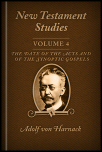
Based on literary analysis and historical fact, this volume discusses the authorship of the gospel of Luke. Then, compiling biblical data, New Testament Studies, vol. 4 thoroughly dissects issues of when each of the Synoptic Gospels was written, as well as the book of Acts. A chapter entitled “The Primitive Legends of Christendom” concludes this informative resource.
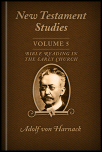
The private usage of the Scriptures is a right that has had an interesting journey and a surprising amount of controversy. Particularly between the Catholic and Protestant Churches, division has been seen as to whether or not individuals may read the Bible, and several noted theologians have debated the topic heavily: Lessing, Goeze, and Walch. Separating the historical analysis by time period, Harnack methodically discusses the subject.
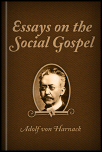
This volume contains a fascinating comparison of the morals taught by Jesus versus the societal morals of the turn of the twentieth century. Harnack explores the difference between a burdensome works-based life and that which is inspired by Christ’s teachings, then analyzing social morals as taught in schools during his era. Education—a topic of equal weight today as it was one hundred years ago—is dissected, from its meaning and values to the dangers that its pursuit can entail, and is weighed against the teachings of Christ.
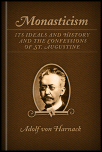
The monastic life has been seen as the ideal manifestation of Christian living throughout various points in history, particularly by the Catholic Church. Chronicling the development of this idea, Harnack questions the superiority of this lifestyle, offering compelling insight into what the Bible says about Christian living and detailing the various examples put forth by the Christian Church throughout history. This volume provides a holistic look at the subject of monasticism within the framework of the question of the manifestation of Christ in us through daily living.
The record of the life of St. Augustine (345&ndas;430) is found in The Confessions of St. Augustine, and records in great detail the life of one of the Church’s earliest saints. Harnack’s thoughts on St. Augustine’s life make up the second portion of this volume, and they offer a fantastic continuation of the study of what it means to live in Christ.
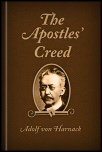
In this volume, Harnack takes on the task of interpreting the Apostles’ Creed historically. Rich with detailed research and extensive in notes, The Apostles’ Creed looks closely at these three creeds: the Apostolic, the Nicene-Constantinopolitan, and the Athanasian.
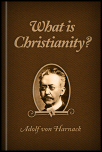
What Is Christianity? And, more importantly, Who is Jesus Christ? Neither of those questions are easily answered, as conflicting information swirls around us. Comprised of over a dozen lectures, What Is Christianity? was delivered originally to an audience of more than 600 students at the University of Berlin with the purpose of clarifying those two questions in the context of history and the Bible.
Lectures Contained
- The Gospel: Preliminary
- The Leading Features of Jesus’ Message
- The Kingdom of God and Its Coming
- God the Father and the Infinite Value of the Human Soul
- The Higher Righteousness and the Commandment of Love
- The Gospel and the World, or the Question of Asceticism
- The Gospel and the Poor, or the Social Question
- The Gospel and Law, or the Question of Public Order
- The Gospel and Work, or the Question of Civilisation
- The Gospel and the Son of God, or the Christological Question
- The Gospel and Doctrine, or the Question of Creed
- The Christian Religion in the Apostolic Age
- The Christian Religion in its Development into Catholicism
- The Christian Religion in Greek Catholicism
- The Christian Religion in Roman Catholicism
- The Christian Religion in Protestantism
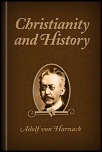
Christianity and History was originally a lecture to the Berlin branch of the Evangelical Union, an organization founded to help protect the Protestant Church from being merged with the Roman Catholic Church. The object of the lecture is “to show in what sense religion, and more especially the Christian religion, can be said to be dependent upon historical facts: how far it is established, if certain alleged events are proved to have actually happened; how far it is overthrown, if they are found to be the product of myth or incredible legend.” The question of whether or not history supports Christianity of high importance, and Harnack’s years of study on the history of dogma well equip him to answer the question. Only 86 pages, this concise lecture is packed with history and persuasive argument for the historical validity of Christianity.
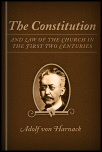
Five essays are contained in this fascinating look at ecclesiastical dogmatics in the first two centuries: The Primitive Community. Jewish Christianity; The Gentile-Christian Communities. Early History, Officials, Documents; Ignatius and the Episcopate. Local Communities; Clergy and Laity. The Ecclesiastical Orders; Church Law. Constitution of Heretical Societies. Synods. Two appendixes, covering the subjects of the Gospel and the fundamental confession of the Church follow the essays, and the volume ends with a supplementary note on the terms “Word,” “Word of God,” and “Word (Words) of Christ,” in the New Testament.
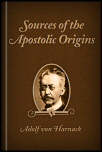
The Reverend John Owen introduces Sources of the Apostolic Canons with an essay entitled “The Organization of the Early Church and the Evolution of the Reader.” A thorough analysis of the sources of the apostolic canons follows, including historical contents, a discussion of dates, and a section labeled “Supplement on the Origin of the Readership and of the Other Lower Orders.”
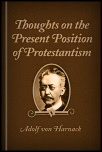
This volume, originally a lecture delivered by Harnack, was put into book form due to the suggestion of a friend with whom he had discussions as to the state of Protestantism in Germany at the time. In seven brief chapters, he lays out the concern that Protestant Germany was headed towards a more legalistic, ritualized, and overly pious way of operating and thinking. Highly controversial at the time that the lecture was given, it was described in a local newspaper as a “radical repudiation of Christianity and of the Christian belief founded on the historical fact of the revelation of God in Christ.” Harnack’s many years of dogmatics study provide an excellent backdrop for this little volume’s analysis of his country’s theological state, and it is a great historical document.
Adolph von Harnack, born in 1851 in Estonia, lived a life devoted to the study of church history and theology. He became a professor at age 24, and taught at the Universities of Leipzig, Giussen, Marbarg, and Berlin until his retirement at age 70. Although he was widely considered to be one of the most influential members of the Protestant church at the turn of the twentieth century, the Church of Germany believed his theology to be off-base and did not allow him to become an accredited clergyman. Harnack’s passion for the history of the Church led him to pen numerous resources on the matter, his most famous work perhaps being What Is Christianity? He continued his studies and writing until his death in 1930.
Reviews
6 ratings
Ray Timmermans
12/11/2016

Larry Proffitt (I
11/13/2013
Bobby Terhune
10/13/2013

Caleb Allen
10/12/2013
Meshaal
10/4/2013

RevSarge
8/5/2013